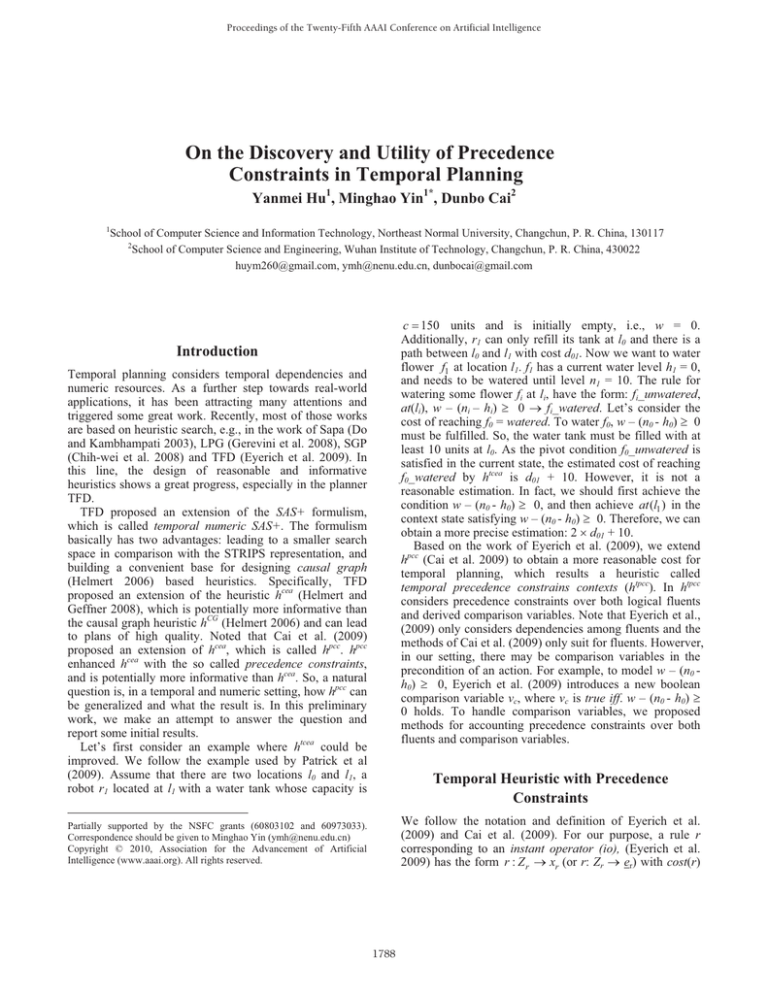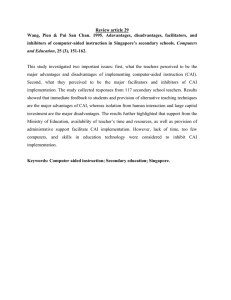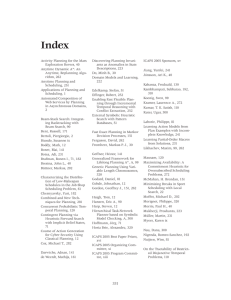
Proceedings of the Twenty-Fifth AAAI Conference on Artificial Intelligence
On the Discovery and Utility of Precedence
Constraints in Temporal Planning
Yanmei Hu1, Minghao Yin1*, Dunbo Cai2
1
School of Computer Science and Information Technology, Northeast Normal University, Changchun, P. R. China, 130117
2
School of Computer Science and Engineering, Wuhan Institute of Technology, Changchun, P. R. China, 430022
huym260@gmail.com, ymh@nenu.edu.cn, dunbocai@gmail.com
c 150 units and is initially empty, i.e., w = 0.
Additionally, r1 can only refill its tank at l0 and there is a
path between l0 and l1 with cost d01. Now we want to water
flower f1 at location l1. f1 has a current water level h1 = 0,
and needs to be watered until level n1 = 10. The rule for
watering some flower fi at li, have the form: fi_unwatered,
at(li), w – (ni – hi) t 0 o fi_watered. Let’s consider the
cost of reaching f0 = watered. To water f0, w – (n0 - h0) t 0
must be fulfilled. So, the water tank must be filled with at
least 10 units at l0. As the pivot condition f0_unwatered is
satisfied in the current state, the estimated cost of reaching
f0_watered by htcea is d01 + 10. However, it is not a
reasonable estimation. In fact, we should first achieve the
condition w – (n0 - h0) t 0, and then achieve at (l1 ) in the
context state satisfying w – (n0 - h0) t 0. Therefore, we can
obtain a more precise estimation: 2 u d01 + 10.
Based on the work of Eyerich et al. (2009), we extend
hpcc (Cai et al. 2009) to obtain a more reasonable cost for
temporal planning, which results a heuristic called
temporal precedence constrains contexts (htpcc). In htpcc
considers precedence constraints over both logical fluents
and derived comparison variables. Note that Eyerich et al.,
(2009) only considers dependencies among fluents and the
methods of Cai et al. (2009) only suit for fluents. Howerver,
in our setting, there may be comparison variables in the
precondition of an action. For example, to model w – (n0 h0) t 0, Eyerich et al. (2009) introduces a new boolean
comparison variable vc, where vc is true iff. w – (n0 - h0) t
0 holds. To handle comparison variables, we proposed
methods for accounting precedence constraints over both
fluents and comparison variables.
Introduction
Temporal planning considers temporal dependencies and
numeric resources. As a further step towards real-world
applications, it has been attracting many attentions and
triggered some great work. Recently, most of those works
are based on heuristic search, e.g., in the work of Sapa (Do
and Kambhampati 2003), LPG (Gerevini et al. 2008), SGP
(Chih-wei et al. 2008) and TFD (Eyerich et al. 2009). In
this line, the design of reasonable and informative
heuristics shows a great progress, especially in the planner
TFD.
TFD proposed an extension of the SAS+ formulism,
which is called temporal numeric SAS+. The formulism
basically has two advantages: leading to a smaller search
space in comparison with the STRIPS representation, and
building a convenient base for designing causal graph
(Helmert 2006) based heuristics. Specifically, TFD
proposed an extension of the heuristic hcea (Helmert and
Geffner 2008), which is potentially more informative than
the causal graph heuristic hCG (Helmert 2006) and can lead
to plans of high quality. Noted that Cai et al. (2009)
proposed an extension of hcea, which is called hpcc. hpcc
enhanced hcea with the so called precedence constraints,
and is potentially more informative than hcea. So, a natural
question is, in a temporal and numeric setting, how hpcc can
be generalized and what the result is. In this preliminary
work, we make an attempt to answer the question and
report some initial results.
Let’s first consider an example where htcea could be
improved. We follow the example used by Patrick et al
(2009). Assume that there are two locations l0 and l1, a
robot r1 located at l1 with a water tank whose capacity is
Temporal Heuristic with Precedence
Constraints
We follow the notation and definition of Eyerich et al.
(2009) and Cai et al. (2009). For our purpose, a rule r
corresponding to an instant operator (io), (Eyerich et al.
2009) has the form r : Z r o xr (or r: Zr o er) with cost(r)
Partially supported by the NSFC grants (60803102 and 60973033).
Correspondence should be given to Minghao Yin (ymh@nenu.edu.cn)
Copyright © 2010, Association for the Advancement of Artificial
Intelligence (www.aaai.org). All rights reserved.
1788
consider htpcc as a promising heuristic and will improve our
implementation in the future work.
= cost(io), where xr is an atom associated with some
logical variable and er is a numeric expression of the form
v1 $ v2 . Zr is a set of atoms that composed by logical
variables or comparison variables.
htpcc ( x | s )
­
°
°0
°°
® c min (c( s c) ° r :Z rc o x
° min (c( s) ° r:Z r ov$vc
°̄ prom( x, s )
htpcc
Domain
htcea
Elevators-numeric
23
29
Elevators-strips
23
26
Crewplanning-strips
29
6
Openstacks-adl
30
30
Openstacks-numeric
30
30
Openstacks-numadl
30
30
Openstacks-strips
30
30
Parcprinter-strips
13
3
Pegsol-strips
29
30
Sokoban-strips
14
7
Transport-numeric
11
11
Woodwork-num
29
27
Total
291
259
Table 1: Number of instances solved with htcea and htpcc.
if x s
if x s,
htpcc ( y | ctc ( y, r c, s c)))
yZ rc
var(x) Vc
¦
¦
yZ r
htpcc ( y | ctc ( y, r , s))) if x s,
var(x) Vc
(1)
In Eq. (1), we extend hpcc (Cai et al. 2009) into a
temporal and numeric setting using instant actions (Eyerich
et al. 2009), which results the heuristic function htpcc.
htpcc(x|s) is the estimated cost of reaching an atom x from a
state s. In Eq. (1), s is the state corresponding to the rule r,
sc is the state corresponding to the rule rc, and ctc(y, r, s) is
the context state associated with the condition y of r, with
respect to s, which is computed like the equations (5) and
(6) in the paper of Cai et al. (2009).
We design a context function (Cai et al. 2009) ctx to
account the precedence constraints over preconditions of a
rule r, where ctx(r , q ) p indicates that the context of
q Z r should be the state that results from
achieving p Z r . To obtain precedence constraints, we
build the following rules:
Rule 1 For p, q Zr, if p and q are landmarks, there are
orderings q o p, q on p or q ogn p, then ctx(p, r) = q.
Rule 2 For p, q Zr, if p is a comparison atom and q is a
logical atom, rc prom(p, s) xc Zrc var(x) = var(q),
then ctx(q, r) = p.
Note that Rule 2 is for accounting the precedence among
comparison variables and logical variables. To consider the
reasonability of Rule 2, we may think cases where the
value change of p involves the value change of q.
Domain
htpcc vs. htcea
Elevators-numeric
+11/-7
Elevators-strips
+7/-21
Crewplanning-strips
+0/-23
Openstacks-adl
+3/-7
Openstacks-numeric
+7/-0
Openstacks-numadl
+10/-10
Openstacks-strips
+1/-0
Parcprinter-strips
+0/-10
Pegsol-strips
+7/-4
Sokoban-strips
+1/-8
Transport-numeric
+5/-4
Woodwork-num
+8/-6
Table 2: Plan quality comparison.
References
Cai, D., Hoffmann, J., and Helmert, M. 2009. Enhancing
the context-enhanced additive heuristic with precedence
constraints. In Proc. ICAPS’09, 50-57.
Chih-wei, Hsu., and Benjamin W, Wah. 2008. The SGPlan
planning system. In IPC-6.
Do, M. B., and Kambhampati, S. 2003. Sapa: A multiobjective metric temporal planner. JAIR 20:155–194.
Gerevini, A., Saetti, A., and Serina, I. 2008. An approach
to efficient planning with numerical fluents and multicriteria plan quality. AIJ 172(8-9):899–944.
Helmert, M. 2006. The Fast Downward planning system.
JAIR 26:191–246.
Helmert, M., and Geffner, H. 2008. Unifying the causal
graph and additive heuristics. In Proc. ICAPS’08, 140-147.
Eyerich, P.; Mattmuller, R.; and Gabriele, R. 2009. Using
the context-enhanced additive heuristic for temporal and
numeric planning. In Proc. ICAPS’09, 130-137.
Richter, S., Helmert, M., and Westphal, M. 2008.
Landmarks Revisited. In Proc. AAAI’08, 975-982.
Experimental Results and Conclusions
To evaluate htpcc, we implement it on top of the code of
Fast Downward (Helmert 2006) and LAMA (Richter et al.
2008), and test it on 12 benchmarks used in the temporal
satisficing track of IPC 2008, with htcea as a reference. All
experiments are done on a PC with a 2.4GHz CPU and
3GB memory. The limit on time is 30 miniutes and on
memory is 2GB. Table 1 shows, for each heuristic, the
number of solved problems on each domain. Table 2
compares the plan quality resulted from using htpcc and that
resulted from using htcea on problems in each domain. In
Tab. 2, +n/-m indicates that htpcc results better plans on n
problems while results worse plans on m problems when
compared with htcea.
From Tab. 1, we can see htpcc is worse than htcea totally,
which is mostly due to our currently very rough
implementation. From Tab. 2, we can see that htpcc leads to
better plans than htcea dose on 6 domains. Therefore, we
1789










